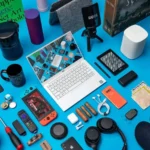Introduction: A Quick Answer Overview
How smartphones changed photography forever is a story of speed, accessibility, and creativity. What once required heavy equipment and technical skill now fits in a pocket. The mobile photography revolution has blurred the line between professionals and amateurs. From Woodstock to Instagram, the rise of smartphone cameras has reshaped not just how we take pictures, but how we live and share them.
The Digital Photography Evolution Begins
The early 2000s marked the digital photography evolution, when film cameras gave way to compact digital ones. Yet even these pocket devices were soon overtaken by smartphone innovation. With each generation, phone makers improved photography technology, offering better sensors, sharper lenses, and higher resolution. The camera quality in smartphones became a selling point, pulling in both casual and serious users.
The transformation did not stop at hardware. The link between photography history and modern design is striking. Where once only professionals documented events, now anyone with a phone can capture moments instantly. This shift opened the door to a new era of mobile creativity and storytelling.
Photography Accessibility for Everyone
Perhaps the biggest change is photography accessibility. Once limited by cost and technical barriers, photography is now open to all. A pocket-sized camera means no one misses a moment, from a child’s first step to breaking news.
- The convenience of smartphone cameras ensures images are ready in seconds.
- Instant photo sharing allows memories to spread worldwide.
- The photo sharing culture fosters constant connection.
- Mobile photo editing apps turn anyone into an editor.
- The democratization of photography lets every voice be seen.
This shift created a wave of everyday photographers, whose images fill feeds, headlines, and even history books.
Cultural Impact of Photography in Daily Life
The cultural impact of photography is profound. Photos are no longer rare, printed treasures. Instead, they are an everyday language of communication. People use selfies, memes, and snapshots to express identity, mood, and opinion.
Social media influence on photography cannot be ignored. Platforms like Instagram, TikTok, and Snapchat made images the central currency of online life. The rise of user-generated content changed marketing, journalism, and even politics. Ordinary people became visual storytellers shaping global conversations.
Smartphone vs Traditional Cameras Debate
The smartphone vs traditional cameras debate reflects both nostalgia and progress. DSLR and mirrorless systems still dominate in professional settings, offering precision and depth. Yet, the shift from DSLR to smartphones is real. For many, phones are good enough to replace heavy gear.
In fact, even professionals now practice professional smartphone photography for convenience. News outlets, travel bloggers, and wedding shooters often rely on phones as backup tools. This hybrid approach highlights how the mobile photography revolution blends old and new.
Candid Photography and Everyday Moments
Before smartphones, candid photography was harder to achieve. Carrying a bulky device often spoiled the natural flow of life. But a phone slips into any setting, unnoticed. This has made casual photography an art in itself.
The ability to capture photography at events (e.g., Woodstock) has shifted over time. Where once only trained photographers documented festivals, protests, or concerts, now the crowd contributes its own lens. These multiple perspectives form a richer cultural archive.
Instant Gratification in Photography
One of the defining features of smartphone photography is instant gratification in photography. There is no waiting for film to develop, or even for memory cards to transfer. A picture appears on-screen instantly, ready to edit, share, or delete.
This has fueled both photography trends and habits. People experiment more, because the cost of failure is low. Combined with mobile photo editing apps, this quick feedback loop encourages creativity at every level.
Smartphone Photojournalism in Real Time
Smartphone photojournalism has reshaped news. Citizens on the ground now often break stories before reporters arrive. Natural disasters, protests, and breaking events are instantly documented. The speed of instant photo sharing means audiences no longer wait for traditional coverage.
The credibility of these images is both a strength and a challenge. While authentic, they can also be manipulated. Still, the mobile storytelling that emerges gives a voice to people who were once silent in photography history.
Technology and Creativity Unite
The link between technology and creativity is clearest in photography. Smartphone innovation is not just about sharper megapixels, but also about AI features, portrait modes, and night vision. These upgrades fuel new forms of expression.
For artists, mobile creativity means experimenting with light, color, and editing without heavy gear. For professionals, it offers portability and freedom. Together, they drive the ongoing digital photography evolution, merging artistry with accessibility.
Mobile Storytelling and Identity
At its heart, mobile storytelling is about identity. Photos tell who we are, where we go, and what we value. In this way, everyday photographers become curators of their lives.
Photo sharing culture also builds communities. Shared hashtags and trends unite people across borders. From activism to hobbies, the cultural impact of photography lies in its power to connect.
Casual Photography as a Lifestyle
The rise of casual photography highlights a new lifestyle. People no longer photograph only milestones. Meals, pets, workouts, and landscapes all become part of daily archives.
This abundance shifts how memory works. Instead of selective moments, we now record everything. The mobile photography revolution thus changes not only culture but even how people remember their lives.
Professional Smartphone Photography Rises
A growing field is professional smartphone photography. Campaigns, magazine covers, and even films have been shot on phones. This challenges the old hierarchy of tools.
The smartphone vs traditional cameras debate now includes economics. Phones are cheaper, lighter, and connected. While DSLRs remain powerful, the shift from DSLR to smartphones is a practical choice for many professionals.
Photography Trends in the Social Era
New photography trends emerge every year thanks to mobile tech. Filters, AR effects, and 360-degree shots are examples. The social media influence on photography drives these trends rapidly.
At the same time, instant photo sharing means trends spread globally within hours. From viral challenges to creative campaigns, the speed of diffusion is unmatched in photography history.
The Future of Smartphone Innovation
Looking ahead, smartphone innovation shows no signs of slowing. Foldable phones, 3D imaging, and AI-enhanced lenses point to the future. The digital photography evolution continues as technology adapts to human needs.
The next era may include holographic capture or advanced mobile storytelling features. But the essence remains: smartphone photography is here to stay, shaping how the world sees itself.
Table: Smartphones vs Traditional Cameras
| Feature | Smartphones | Traditional Cameras (DSLR/Mirrorless) |
| Accessibility | High – always in pocket | Low – requires gear |
| Editing | Instant with apps | Post-processing on PC |
| Sharing | Immediate online | Manual transfer |
| Professional Quality | Growing rapidly | Still dominant |
| Cultural Role | Everyday life, casual + professional | Mostly professional/artistic |
Conclusion: A Lasting Transformation
In short, how smartphones changed photography forever is a story of accessibility, speed, and creativity. The blend of photography technology, mobile photography revolution, and social media influence on photography has created a new culture of visual expression. What began as a convenience has become a global language. The future will only deepen this shift, as smartphone cameras continue to push boundaries and redefine both art and memory.
FAQs
1. What is the biggest impact of smartphone photography?
It made photography accessible to everyone, not just professionals.
2. How did smartphones affect traditional cameras?
They reduced demand for entry-level cameras, but professionals still use DSLRs.
3. Can professional work be done with smartphones?
Yes, many ads, magazines, and even films use phones today.
4. What role does social media play?
It drives trends and makes photos central to online identity.
5. How do editing apps change photography?
They let anyone enhance or transform images instantly.
6. Why is smartphone photojournalism important?
It documents events in real time, often before media arrives.
7. How does casual photography affect memory?
It creates massive personal archives of daily life.
8. What is instant gratification in photography?
It’s the ability to see, edit, and share photos instantly.
9. Will smartphones replace professional cameras?
Not fully, but they are becoming powerful enough for many uses.
10. What is the future of mobile photography?
Expect AI, 3D imaging, and new creative tools to redefine it further.


